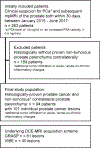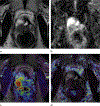Compressed Sensing Radial Sampling MRI of Prostate Perfusion: Utility for Detection of Prostate Cancer
- PMID: 30599102
- PMCID: PMC6924615
- DOI: 10.1148/radiol.2018180556
Compressed Sensing Radial Sampling MRI of Prostate Perfusion: Utility for Detection of Prostate Cancer
Abstract
Purpose To investigate the diagnostic performance of a dual-parameter approach by combining either volumetric interpolated breath-hold examination (VIBE)- or golden-angle radial sparse parallel (GRASP)-derived dynamic contrast agent-enhanced (DCE) MRI with established diffusion-weighted imaging (DWI) compared with traditional single-parameter evaluations on the basis of DWI alone. Materials and Methods Ninety-four male participants (66 years ± 7 [standard deviation]) were prospectively evaluated at 3.0-T MRI for clinical suspicion of prostate cancer. Included were 101 peripheral zone prostate cancer lesions. Histopathologic confirmation at MRI transrectal US fusion biopsy was matched with normal contralateral prostate parenchyma. MRI was performed with diffusion weighting and DCE by using GRASP (temporal resolution, 2.5 seconds) or VIBE (temporal resolution, 10 seconds). Perfusion (influx forward volume transfer constant [Ktrans] and rate constant [Kep]) and apparent diffusion coefficient (ADC) parameters were determined by tumor volume analysis. Areas under the receiver operating characteristic curve were compared for both sequences. Results Evaluated were 101 prostate cancer lesions (GRASP, 61 lesions; VIBE, 40 lesions). In a combined analysis, diffusion and perfusion parameters ADC with Ktrans or Kep acquired with GRASP had higher diagnostic performance compared with diffusion characteristics alone (area under the curve, 0.97 ± 0.02 [standard error] vs 0.93 ± 0.03; P < .006 and .021, respectively), whereas ADC with perfusion parameters acquired with VIBE had no additional benefit (area under the curve, 0.94 ± 0.03 vs 0.93 ± 0.04; P = .18and .50, respectively, for combination of ADC with Ktrans and Kep). Conclusion If used in a dual-parameter model, incorporating diffusion and perfusion characteristics, the golden-angle radial sparse parallel acquisition technique improves the diagnostic performance of multiparametric MRI examinations of the prostate. This effect could not be observed combining diffusing with perfusion parameters acquired with volumetric interpolated breath-hold examination. © RSNA, 2018.
Conflict of interest statement
Disclosures of Conflicts of Interest:
Figures




References
-
- Lüdemann L, Prochnow D, Rohlfing T, et al. Simultaneous quantification of perfusion and permeability in the prostate using dynamic contrast-enhanced magnetic resonance imaging with an inversion-prepared dual-contrast sequence. Ann Biomed Eng 2009;37(4):749–762. - PubMed
-
- van Niekerk CG, van der Laak JAWM, Hambrock T, et al. Correlation between dynamic contrast-enhanced MRI and quantitative histopathologic microvascular parameters in organ-confined prostate cancer. Eur Radiol 2014;24(10):2597–2605. - PubMed
-
- Langer DL, van der Kwast TH, Evans AJ, Trachtenberg J, Wilson BC, Haider MA. Prostate cancer detection with multi-parametric MRI: Logistic regression analysis of quantitative T2, diffusion-weighted imaging, and dynamic contrast-enhanced MRI. J Magn Reson Imaging 2009;30(2):327–334. - PubMed
-
- Giannini V, Mazzetti S, Armando E, et al. Multiparametric magnetic resonance imaging of the prostate with computer-aided detection: experienced observer performance study. Eur Radiol 2017;27(10):4200–4208. - PubMed
MeSH terms
Substances
Grants and funding
LinkOut - more resources
Full Text Sources
Medical

